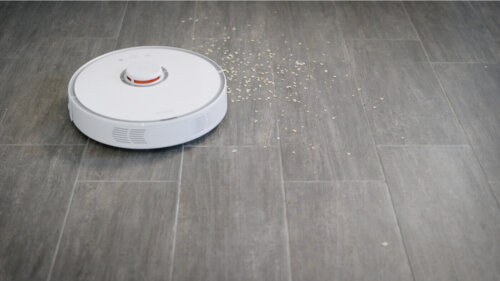Is Technology Distorting the Concept of the Traditional Home?

Innovations are becoming increasingly common in our day-to-day lives. You can find all types of developments that have replaced the most deeply rooted customs at work, on the street, and even at home. But is technology really distorting the concept of the traditional home?
You’re probably aware of the fact that computer systems are increasingly present in people’s lives, to such an extent that people have included resources in their homes that, ultimately, make things easier for them.
However, some people prefer to maintain a traditional decorative style or resort to basic appliances instead of buying new technologies. This is probably due to their need to continue maintaining traditional patterns.
Why has the concept of the traditional home become distorted?

The concept of the “traditional home” has changed a lot in recent years. This doesn’t mean that it’s become obsolete or that it has no future possibilities. However, its function and application have been somewhat distorted.
Big decoration brands are working hard to design furniture that’s more original and relaxed and represents an aesthetic revolution. Perhaps this is the approach that will gain ground in the coming decades, as it tries to offer a more contemporary aesthetic.
In turn, technology has addressed comfort and has saved people a lot of time and effort. Now you can open and close your blinds with the push of a button, turn on the lights by clapping your hands, or clean your windows with an automatic appliance.
Technical novelties are making their way on the market to reach all homes.
What elements from the traditional home are disappearing?
Although it may not seem like it, some trends are changing. To a certain extent, people aren’t applying a personalized style. In fact, many people are putting their trust in professionals to decorate their interiors. But these professionals tend to decorate without taking their clients’ personalities into account.
Below, we’re going to explain some of the formulas that are disappearing and you’ll also discover the elements of modern homes:
- Nowadays, people are using the surfaces of their walls to mount televisions. In fact, TVs are more important now than ever. Before, people simply integrated them as pieces of furniture.
- Attention to detail has been put aside in favor of an aesthetic generalism where simplicity and openness prevail. The new furniture approaches have become more technical.
- As for lighting, direct and functional lighting is more popular nowadays than general and open lighting. Ceiling lamps have lost that focus and importance. Now, spotlights, lamps, and floor lamps are more popular.
- Numerous household elements have been designed to allow people to enjoy greater comfort. This is because people don’t spend as much time at home anymore. We’re always in a hurry to do things quickly and we want to take advantage of every moment without wasting a single minute of our time. This is where home automation comes in.
Technology in the kitchen

In the traditional home, simple, basic, and functional kitchenware was used. The recipes people have cooked for years, those that, until now, were prepared with the processes our ancestors passed down, are no longer popular.
Today, you can buy programmable pots, kitchen robots, pans that you can control with your cell phone, etc. The world is becoming increasingly modernized. This benefits you in many areas and helps you save time, as you can see with household appliances.
We consider this very positive. However, the ideas and approaches that people used to use to make food are disappearing. As a result, experts are inventing other very interesting developments.
Progress has reached every home
One aspect to keep in mind is that every home can access technological resources. This is because you can find different prices and types on the market. In addition, you can also find products with a very good value for money.
Innovations are becoming increasingly common in our day-to-day lives. You can find all types of developments that have replaced the most deeply rooted customs at work, on the street, and even at home. But is technology really distorting the concept of the traditional home?
You’re probably aware of the fact that computer systems are increasingly present in people’s lives, to such an extent that people have included resources in their homes that, ultimately, make things easier for them.
However, some people prefer to maintain a traditional decorative style or resort to basic appliances instead of buying new technologies. This is probably due to their need to continue maintaining traditional patterns.
Why has the concept of the traditional home become distorted?

The concept of the “traditional home” has changed a lot in recent years. This doesn’t mean that it’s become obsolete or that it has no future possibilities. However, its function and application have been somewhat distorted.
Big decoration brands are working hard to design furniture that’s more original and relaxed and represents an aesthetic revolution. Perhaps this is the approach that will gain ground in the coming decades, as it tries to offer a more contemporary aesthetic.
In turn, technology has addressed comfort and has saved people a lot of time and effort. Now you can open and close your blinds with the push of a button, turn on the lights by clapping your hands, or clean your windows with an automatic appliance.
Technical novelties are making their way on the market to reach all homes.
What elements from the traditional home are disappearing?
Although it may not seem like it, some trends are changing. To a certain extent, people aren’t applying a personalized style. In fact, many people are putting their trust in professionals to decorate their interiors. But these professionals tend to decorate without taking their clients’ personalities into account.
Below, we’re going to explain some of the formulas that are disappearing and you’ll also discover the elements of modern homes:
- Nowadays, people are using the surfaces of their walls to mount televisions. In fact, TVs are more important now than ever. Before, people simply integrated them as pieces of furniture.
- Attention to detail has been put aside in favor of an aesthetic generalism where simplicity and openness prevail. The new furniture approaches have become more technical.
- As for lighting, direct and functional lighting is more popular nowadays than general and open lighting. Ceiling lamps have lost that focus and importance. Now, spotlights, lamps, and floor lamps are more popular.
- Numerous household elements have been designed to allow people to enjoy greater comfort. This is because people don’t spend as much time at home anymore. We’re always in a hurry to do things quickly and we want to take advantage of every moment without wasting a single minute of our time. This is where home automation comes in.
Technology in the kitchen

In the traditional home, simple, basic, and functional kitchenware was used. The recipes people have cooked for years, those that, until now, were prepared with the processes our ancestors passed down, are no longer popular.
Today, you can buy programmable pots, kitchen robots, pans that you can control with your cell phone, etc. The world is becoming increasingly modernized. This benefits you in many areas and helps you save time, as you can see with household appliances.
We consider this very positive. However, the ideas and approaches that people used to use to make food are disappearing. As a result, experts are inventing other very interesting developments.
Progress has reached every home
One aspect to keep in mind is that every home can access technological resources. This is because you can find different prices and types on the market. In addition, you can also find products with a very good value for money.
All cited sources were thoroughly reviewed by our team to ensure their quality, reliability, currency, and validity. The bibliography of this article was considered reliable and of academic or scientific accuracy.
Junestrad, Stefan; Passaret, Xavier; Vázquez, Daniel: Domótica y hogar tradicional, Madrid, Paraninfo, 2005.







